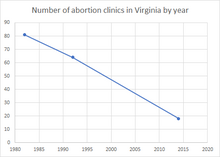History
Virginia's journey through the legislative, judicial, and clinic histories regarding abortion underscores the state's ever-evolving approach to reproductive healthcare. Dating back to the late 1800s, when Virginia, akin to many states, implemented bans on abortion with therapeutic exceptions, the state aimed to navigate the delicate balance between protecting women's lives and regulating abortion practices. Over time, pivotal legal shifts reshaped Virginia's abortion landscape, starting with significant reforms in 1970 to align its laws with evolving legal standards.
In the 2023 United States elections in Virginia, Democrats retook full control of the General Assembly after campaigning on abortion rights following Governor Glenn Youngkin's promise to institute a 15-week abortion ban in the state if the Republicans gained a majority. [2]
Legislative history
Virginia's legislative history regarding abortion reflects a continual evolution of laws and regulations that have shaped access to reproductive healthcare. In the late 1800s, the state, like many others, had bans on abortion, with therapeutic exceptions. These exceptions allowed for abortions in cases where the mother's life was in danger. The legislation was aimed at reducing fatalities resulting from unsafe abortion procedures during that era.
In 1970, Virginia made significant reforms to its abortion laws, following the American Law Institute's Model Penal Code. This marked a shift in the state's approach to reproductive rights, aligning its regulations with evolving legal standards.
Throughout the following decades, Virginia introduced various regulations impacting abortion access. By 2007, the state was among those with detailed abortion-specific informed consent requirements, ensuring that individuals seeking abortion were provided specific information before the procedure.
In 2013, Virginia implemented Targeted Regulation of Abortion Providers (TRAP) laws, imposing stringent requirements not only on abortion clinics, but also on private doctor offices and medication-induced abortions. These regulations sparked debates around their impact on access to abortion services and the health-care landscape.
In mid-May 2019, Virginia passed legislation banning abortion after the 25th week of pregnancy, further influencing the timeline for legal abortion procedures in the state.
In April 2020, Governor Ralph Northam signed bills removing certain abortion-related regulations. These bills eliminated requirements such as mandatory ultrasounds and social counseling on abortion alternatives 24 hours before the procedure. They also expanded health-care professionals authorized to perform first-trimester abortions, and removed the designation of facilities performing more than five abortions annually as hospitals.
Presently, Virginia prohibits abortions in the third trimester, except when continuing the pregnancy poses an imminent danger to the woman's life, as certified by a physician. This requires the certification of three doctors if terminating the pregnancy is deemed necessary due to the likelihood of the patient's death or substantial and irremediable impairment to her mental or physical health.
On February 7, 2024, the Virginia House rejected a bill that would have instituted a near-total abortion ban. [3]
Judicial history
The US Supreme Court's decision in 1973's Roe v. Wade ruling meant the state could no longer regulate abortion in the first trimester. [4] (However, the Supreme Court overturned Roe v. Wade in Dobbs v. Jackson Women's Health Organization , No. 19-1392 , 597 U.S. ___(2022) later in 2022. [5] [6] )
The judicial history of abortion in Virginia is emblematic of the intricate and contentious legal terrain that has defined reproductive rights in the United States. Preceding the watershed ruling of Roe v. Wade in 1973, Virginia, like many states, enforced stringent abortion regulations. In 1972, the constitutionality of Virginia's abortion statutes came under scrutiny in the case of "United States v. Vuitch," ultimately reaching the hallowed chambers of the U.S. Supreme Court. The decision in Vuitch, though not a sweeping invalidation of Virginia's abortion laws, did provide essential elucidation on the criteria for medical judgment in determining the necessity of an abortion.
In the wake of the Roe v. Wade decision, Virginia, like its counterparts, was compelled to recalibrate its abortion laws to align with the newfound constitutional framework. The 1975 Supreme Court case "Planned Parenthood of Central Missouri v. Danforth" reaffirmed the principles established in Roe, thus necessitating the amendment of Virginia's abortion laws to fall in line with the constitutional mandate. Hence, during the first trimester, the state could no longer impose undue restrictions on abortion, safeguarding a woman's right to choose during this critical period.
Nonetheless, the legacy of Roe v. Wade was not without its legal challenges. As previously noted, the year 2022 bore witness to the pivotal case of "Dobbs v. Jackson Women's Health Organization," wherein the Supreme Court decided to overturn the hitherto sacrosanct precedent set by Roe. This momentous decision precipitated a sea change in the legal landscape, endowing states with greater autonomy to regulate abortion. Consequently, Virginia and other states find themselves at the cusp of a new legal paradigm, where the future of abortion rights is beset with uncertainties, poised for continuous transformation, and inexorably tethered to the multifaceted fabric of American jurisprudence. The evolution of this contentious and complex issue underscores the dynamism of the legal landscape, with profound implications for Virginia and the nation as a whole.[ citation needed ]
Clinic history

Between 1982 and 1992, the number of abortion clinics in the state declined by seventeen, going from 81 in 1982 to 64 in 1992. [7] In 2014, there were eighteen abortion clinics in the state. [8] In 2014, 92% of the counties in the state did not have an abortion clinic. That year, 78% of women in the state aged 15–44 lived in a county without an abortion clinic. [9] In 2017, there were five Planned Parenthood clinics, of which four offered abortion services, in a state with a population of 1,971,590 women aged 15–49. [10]
In 2017 17,210 abortions were done in Virginia. Not all of these were done for people who were residents of the state, many people had to travel from farther due to their state not providing this option.
On May 9, 2007, an unidentified person deliberately set fire to a Planned Parenthood clinic in Virginia Beach, Virginia. [11]

